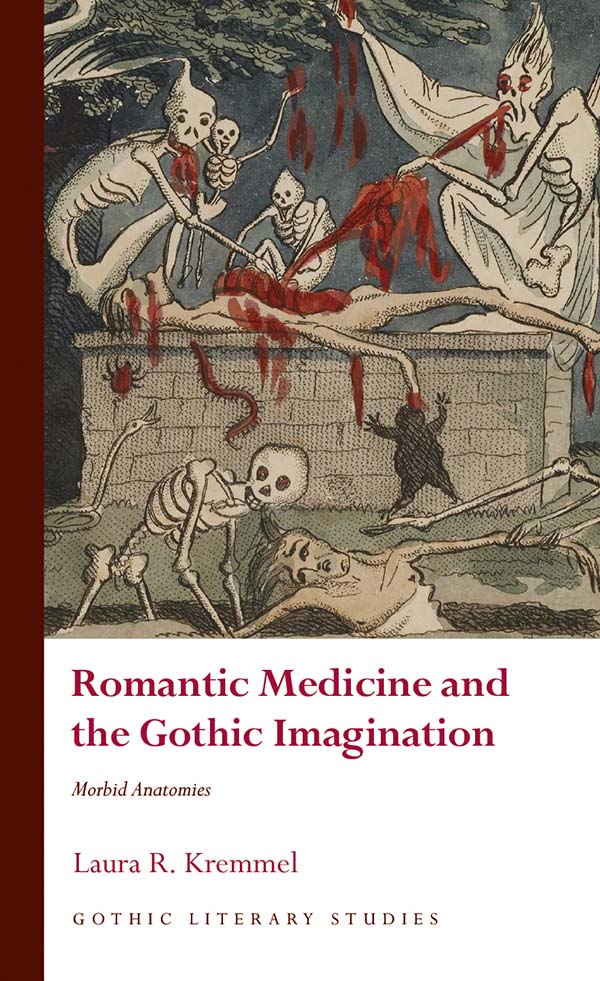Romantic Medicine and the Gothic Imagination
Morbid Anatomies
Awdur(on) Laura R. Kremmel
Iaith: Saesneg
Dosbarthiad(au): Literary Criticism
Cyfres: Gothic Literary Studies
- Ebrill 2022 · 272 tudalen ·216x138mm
- · Clawr Caled - 9781786838483
- · eLyfr - pdf - 9781786838490
- · eLyfr - epub - 9781786838506
Am y llyfr
This book debates a crossover between the Gothic and the medical imagination in the Romantic period. It explores the gore and uncertainty typical of medical experimentation, and expands the possibilities of medical theories in a speculative space by a focus on Gothic novels, short stories, poetry, drama and chapbooks. By comparing the Gothic’s collection of unsavoury tropes to morbid anatomy’s collection of diseased organs, the author argues that the Gothic’s prioritisation of fear and gore gives it access to nonnormative bodies, reallocating medical and narrative agency to bodies considered otherwise powerless. Each chapter pairs a trope with a critical medical debate, granting silenced bodies power over their own narratives: the reanimated corpse confronts fears about vitalism; the skeleton exposes fears about pain; the unreliable corpse feeds on fears of dissection; the devil redirects fears about disability; the dangerous narrative manipulates fears of contagion and vaccination.
Dyfyniadau
‘This volume is an exhilarating exploration of the shadowy hinterland that was shared by medical discourse and Gothic writing in the late-eighteenth and early-nineteenth centuries. Across five engaging and fluently written chapters, the book brilliantly reveals the extent to which some of the Gothic’s most distinctive and enduring tropes – blood, corpses, skeletons, disabled bodies – were steeped in contemporary medical thought, all the while reminding us that Romantic medicine was itself inevitably a Gothic affair. As major a contribution to Gothic Studies as it is to the fields of Romanticism and the Medical Humanities more broadly, Romantic Medicine is an extraordinary feat of critical revivification that infuses fresh life-blood into the pathological corpus of early Gothic romance, poetry and drama.’
Dale Townshend, Professor of Gothic Literature, Manchester Centre for Gothic Studies
‘An inventive, authoritative, and engaging inquiry into the medical background lurking behind some of the best-known – and once most-maligned – Gothic literature, Laura Kremmel’s Romantic Medicine and the Gothic Imagination reveals how the study of “morbid anatomy” both grounds and complicates literary narratives about nonnormative, “disobedient” bodies. This book is a necessary addition to the critical field of Romantic medicine.’
Michelle Faubert, Professor of Romantic Literature, University of Manitoba; Visiting Fellow, Northumbria University
‘This is a gripping, important analysis of the way Gothic representation and the medical imaginary converge in the eighteenth and nineteenth centuries. Kremmel’s elegant analysis shows how Gothic functioned as a speculative force, both embracing and challenging period thinking about death and disease. Emphasising diverse practices and agents, Kremmel demonstrates the decentralisation of medical agency and authority at this period. This book enriches the fields of Romanticism, the Gothic, and medical humanities.’
Dr Sara Wasson, Reader in Gothic Studies, Lancaster University
Cynnwys
Acknowledgements
Introduction: The Laboratory of the Gothic Imagination
Chapter 1: Reanimated Corpses, Blood, and the Gothic Vital Element
Chapter 2: Anaesthetic Skeletons and the Pain of Melancholy
Chapter 3: Counterfeit Corpses and Evaded Dissection
Chapter 4: The Devil and the Disability Narrative
Chapter 5: Contagious Narratives and Gothic Vaccination
Conclusion
Notes
Bibliography
Index


